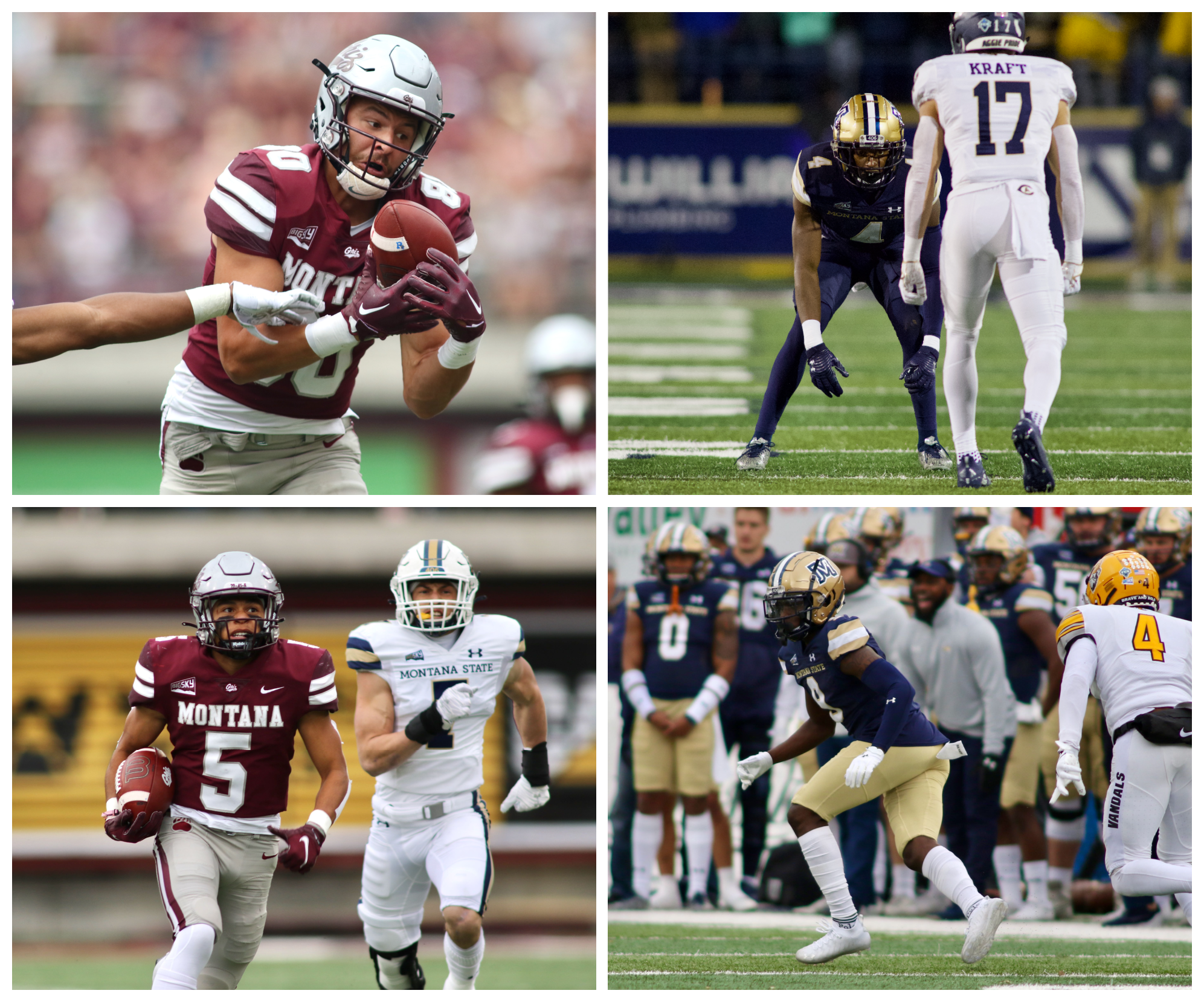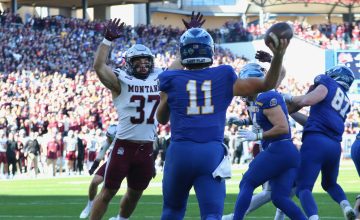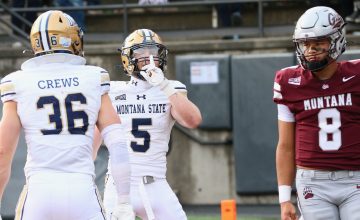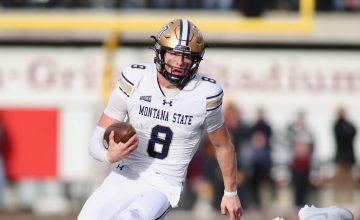You don’t have to go back very far to see the impact that big plays can have on the Brawl of the Wild.
Last year at Washington-Grizzly Stadium, Montana and Montana State had just 13 first downs apiece and neither averaged more than 2.5 yards per rush or more than five yards per play.
But the Grizzlies seized momentum with a 74-yard touchdown pass from Cam Humphrey to Junior Bergen on the second play of the game – their only offensive touchdown, it turned out – and never gave it back in a 29-10 win.
If points are once again hard to come by – Montana’s defense is repeating as one of the best in the country, although Montana State’s has taken a step back after losing NFLers Troy Andersen and Daniel Hardy – explosive plays could be even more of a deciding factor in this year’s matchup.
That makes sense. If long drives are unlikely, big plays are the best way to score, and if there aren’t going to be many points in total, just a few long scoring plays would have an outsized impact on the result. Mistakes matter, and could be a determining factor in an otherwise even rivalry showdown.

The issue for Montana is that big offensive plays have been about as likely for the Griz this year as seeing an actual grizzly bear tap-dancing at the 50-yard line in Washington-Grizzly Stadium.
Until Nick Ostmo’s 80-yard touchdown run last week against what could charitably be described as a porous Eastern Washington defense, the Griz hadn’t had even one play this season as long as Bergen’s tone-setting touchdown in last year’s rivalry game.
In between Marcus Knight’s 48-yard run late in a victory over Idaho State on Oct. 1 and Isiah Childs’ 43-yard touchdown burst late in a blowout of Cal Poly on Nov. 5, the Griz didn’t have a single play of longer than 40 yards (and, given Knight is now confirmed to have entered the transfer portal, you’d have to go back even further, to Xavier Harris’s 64-yard touchdown run against Portland State on Sept. 24, to find a 40-plus-yard play from a player who’s still on the roster).
That month-long stretch coincided with a three-game losing streak that now makes the Brawl of the Wild a must-win for the Griz if they want to be absolutely assured of a playoff spot.
Starting quarterback Lucas Johnson missed one of those games and most of another with an injury, but the lack of explosive plays, particularly in the passing game, has been an issue all season long for Montana.
Now, that deficiency is at the heart of one of the most intriguing and potentially impactful matchups in this year’s rivlary as Montana takes on Montana State this weekend in Bozeman. The Grizzlies’ offense has struggled to create big plays, especially for its wide receivers. But on the other side of the Continental Divide, that’s proven to be one of the best ways to attack a Montana State defense that’s a level or two below its imperious best from 2021.
***
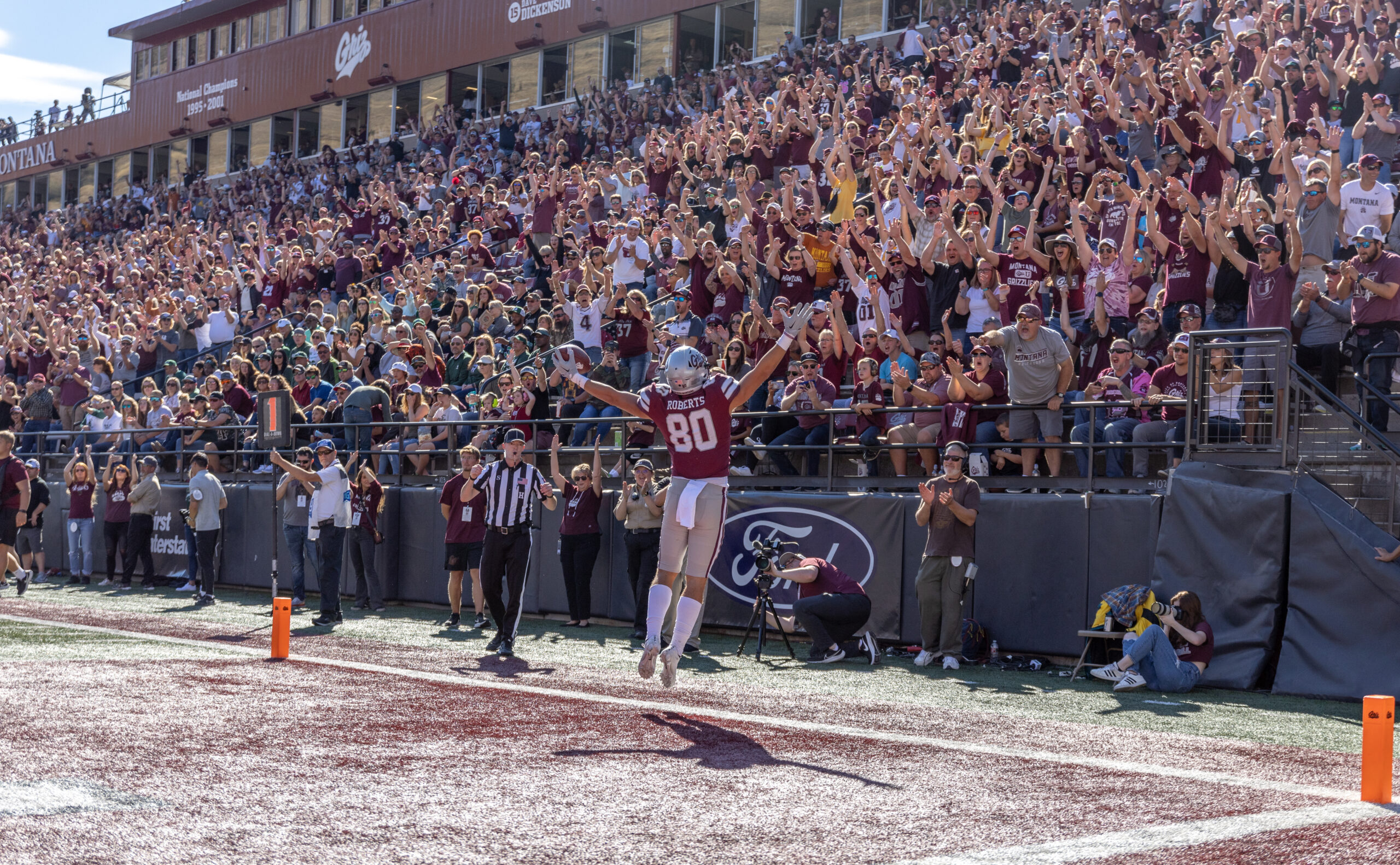
Three-and-a-half minutes into Montana’s season, Mitch Roberts looked like he was going to be an All-American.
Against Northwestern State in Montana’s season opener, the redshirt senior from Missoula Sentinel caught his first target of the year for 11 yards, then came back a play later, taking a wide receiver screen for an untouched 30-yard touchdown.
He added a 13-yard touchdown catch two drives later – putting him briefly on pace for an 88-touchdown season – and finished the game with six catches for 103 yards and the two scores.

It was an encouraging beginning for an inexperienced wide receiver corps that counted Roberts as its only productive returning veteran. Then, when redshirt freshman Aaron Fontes had eight catches for 93 yards two weeks later against Indiana State, it looked like the youngsters were gearing up to give him some help.
But two-and-a-half months later, Roberts’ 103 yards from the season opener are still a season-high for Montana’s wide receivers, as are his two touchdowns (matched in that game by Bergen).
He has just one catch longer than that 30-yard touchdown, a 35-yarder against Eastern Washington.
Malik Flowers’ longest catch of the year is good for 35 yards, Keelan White’s for 36, Fontes’s for just 22 (and his 93 yards from the Indiana State game are over a third of his 261 for the season). Bergen’s 47-yard touchdown, also from that Northwestern State game all the way back in the beginning of September, is the longest reception of the year by a Montana wide receiver.
Taken together, those numbers tell the story that, after years of reliable production from Samori Toure and Sammy Akem, the Griz don’t have an all-conference level receiver or a reliable way to attack a defense deep. Or at least they haven’t found a way to go to that element of offense with frequency this season.
Junior Bergen (@bergen_junior) made waves with this one-handed catch that landed on SportsCenter's Top 10 plays. One of the most impressive plays I've ever seen, arguably the top play of the year for #GrizFB. Multiple angles on that catch here: pic.twitter.com/AEOQvvzPSB
— Kyle Hansen (@khansen406) October 16, 2022
Roberts is a well-spoken leader, a hometown kid and a legacy Griz – but he hasn’t taken a step forward from the solid but unspectacular veteran wide receiver he was a year ago. He’s averaging an identical 4.2 catches per game but his yards per catch have taken a slight step back, and although he’s Montana’s leading receiver, he’s just 18th in the conference in yards per game.
Flowers, now a senior, has never translated the straight-line speed, vision and electrifying instincts that made him the greatest kick returner in school history over to wideout. White and Fontes, youngsters who caught eyes in spring ball and preseason camp, haven’t broken out.
Bergen has provided an outsized share of the highlight moments for Montana this year, both as a punt returner and on offense, but is still averaging under two catches per game.
It’s tough to tell how much of those disappointing numbers can be attributed to an offensive scheme that seems allergic to taking deep shots and how much to backup quarterback Kris Brown replacing Lucas Johnson for nearly two full games. What’s clearly true is that if they are able to create big plays in the Brawl of the Wild, Montana’s receivers will be doing something they haven’t managed at all so far this year.
“Any given week, it doesn’t change,” Roberts said before this week’s game. “We have to go out there and make plays for our team and hopefully get a win.”
***
On the other side of the matchup, that’s welcome news for a Montana State defense that’s struggled at times to stop the pass, and especially big plays through the air.
One of two touchdowns the Bobcats gave up in their season-opening rout of McNeese State was a 66-yard reception. Two weeks later, Oregon State averaged 11.2 yards per pass attempt against the Bobcats, and the week after that, Eastern Washington’s Freddie Roberson scored on an 80-yard catch in a near-upset.
Two weeks ago, MSU’s offense had to pull out another one-score win over an unranked Big Sky team, Northern Arizona, after Lumberjacks quarterback R.J. Martinez threw for 452 yards and three touchdowns, including a 52-yard deep strike to Coleman Owen and scoring tosses of 48, 36 and 34 yards.
The Bobcats are fifth in the conference in total defense, but that number is boosted by a run defense that’s fourth overall, and just five yards per game away from being second behind the Griz.
MSU’s pass defense, on the other hand, is eighth in the league, giving up over 240 yards per game. In every metric – yards per attempt, touchdowns given up, completion percentage surrendered – the Bobcats sit right in the middle of the conference.
“We still haven’t put together a complete game but we have accomplished some really good things,” MSU senior nickelback Ty Okada said. “We have still not put together our best, yet we’ve gotten to this point, so we are going to continue to work hard and continue to build on it, for sure.”
Like Montana’s wide receivers, Montana State’s secondary has plenty of experience (and like the Griz receivers, it’s difficult to separate their struggles from other factors. Is the pass rush not getting home as quickly as last season? It’s a likely assumption given that FCS sack leader Daniel Hardy is now playing for the Los Angeles Rams).

Cornerbacks James Campbell and Tyrel Thomas are seniors, as is safety Jeffrey Manning Jr. Okada plays more in the box, but he’s also a senior. Simeon Woodard, who starts across from Campbell on the outside, is just a sophomore but played in 14 games and had four interceptions a year ago.
That’s part of what makes this matchup so fascinating – two units that are having underwhelming years, but have plenty of experience and past success. Now, they’ll get a chance for redemption on the biggest stage of all. And if one or the other is able to make a big play – even just one – that could determine the 121st Brawl of the Wild.
Photos by Brooks Nuanez and attributed. All Rights Reserved.

